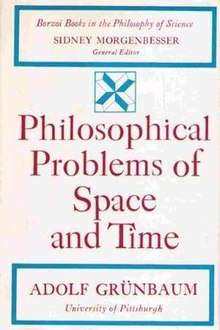Philosophical Problems of Space and Time
 Cover of the first edition | |
| Author | Adolf Grünbaum |
|---|---|
| Country | United States |
| Language | English |
| Subject | Space and time |
| Published |
1963 (first edition) 1973 (second edition) |
| Media type | Print (Hardcover and Paperback) |
| Pages | 884 (second edition) |
| ISBN | 978-9027703583 |
Philosophical Problems of Space and Time (1963; second edition 1973) is a book about the nature of space and time by the philosopher Adolf Grünbaum. It is recognized as a major work in the philosophy of the natural sciences.
Summary
Grünbaum argues that physical geometry and chronometry are in part matters of convention because continuous physical space and time are metrically amorphous.[1] He criticizes the views of a number of other philosophers, including Ernest Nagel and Jacques Maritain, arguing that in The Structure of Science (1961) Nagel misinterprets the philosopher of science Henri Poincaré and that in The Degrees of Knowledge (1932) Maritain presents an unsound and incorrect interpretation of the nature of geometry.[2]
Publication history
Philosophical Problems of Space and Time was first published by Alfred A. Knopf in the United States in 1963. In 1964, the book was published by Routledge and Kegan Paul in the United Kingdom. In 1969, a revised version was published in Russian translation in the Soviet Union by Progress Publishers. In 1973, an enlarged section was published in English by D. Reidel Publishing Company.[3]
Reception
Robert S. Cohen and the philosopher Marx W. Wartofsky, writing in the second edition of Philosophical Problems of Space and Time, stated that the book was "promptly recognized to be one of the few major works in the philosophy of the natural sciences of this generation" upon its original publication. Cohen and Wartofsky believed that this was partly because Grünbaum "admirably exemplifies that Aristotelian devotion to the intimate and mutual dependence of actual science and philosophical understanding" and combined "detail with scope." They credited him with dealing with the "problems of space and time" in their "full depth and complexity".[4]
The philosopher Philip L. Quinn, writing in The Oxford Companion to Philosophy (2005), called Grünbaum's thesis about physical geometry and chronometry "striking".[1]
References
Footnotes
- 1 2 Quinn 2005, p. 355.
- ↑ Grünbaum 1974, pp. 91, 148–150.
- ↑ Grünbaum 1974, pp. iv, xvii.
- ↑ Cohen & Wartofsky 1974, p. xiii.
Bibliography
- Books
- Cohen, Robert S.; Wartofsky, Marx W. (1974). Philosophical Problems of Space and Time. Boston: D. Reidel Publishing. ISBN 90 277 0358 2.
- Grünbaum, Adolf (1974). Philosophical Problems of Space and Time. Boston: D. Reidel Publishing. ISBN 90 277 0358 2.
- Quinn, Philip L.; Honderich, Ted, Editor (2005). The Oxford Companion to Philosophy. Oxford: Oxford University Press. ISBN 0-19-926479-1.